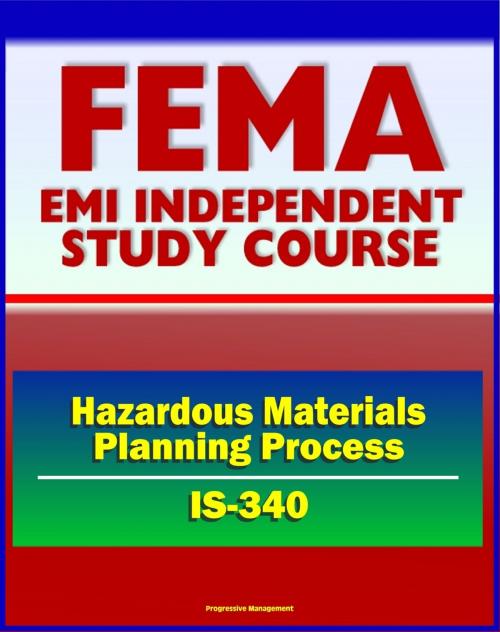21st Century FEMA Study Course: Hazardous Materials Planning Process (IS-340) - EPA Regulations, CERCLA, Superfund, HazMat Training
Nonfiction, Science & Nature, Science, Biological Sciences, Ecology, Social & Cultural Studies, Political Science| Author: | Progressive Management | ISBN: | 9781466108202 |
| Publisher: | Progressive Management | Publication: | July 16, 2011 |
| Imprint: | Smashwords Edition | Language: | English |
| Author: | Progressive Management |
| ISBN: | 9781466108202 |
| Publisher: | Progressive Management |
| Publication: | July 16, 2011 |
| Imprint: | Smashwords Edition |
| Language: | English |
This Federal Emergency Management Agency (FEMA) independent training course manual from the Emergency Management Institute (EMI) introduces you to the Hazardous Materials (HazMat) planning process.
At the end of this course, students should be able to:
Determine who should be involved in the HazMat planning process; Identify and rate HazMat risks in your jurisdiction; Assess response resources to determine limitations and shortfalls; Explore potential sources for needed resources; Develop a HazMat planning strategy ; Develop a strategy for training and exercising the plan.
Hazardous materials have become a part of everyday life. When produced, stored, transported, and used properly, hazardous materials make our lives easier. When mishandled or when accidents occur, hazardous materials can present a deadly threat to public health and safety. Lesson 1 will introduce the benefits of and reasons for HazMat planning.
The basis for HazMat planning lies in Federal and State regulations and local ordinances. It is important that you understand the requirements of regulations and ordinances so that your plan meets all necessary requirements.
HazMat planning should not “start from scratch” but should be based on your jurisdiction's Emergency Operations Plan.
Where should you begin your planning process? What types of incidents should you plan for? What hazards does your jurisdiction face, and what are the risks? Who should be involved? What resources does your jurisdiction have? What might you need? Lesson 3 will help you work through all of these questions so that you can approach the planning process with a strategy that meets your jurisdiction’s needs.
Before you can plan, you need to know the types of incidents to plan for. Identifying the hazards— the chemicals in and around your jurisdiction—will provide information about the types of incidents that could occur. Lesson 4 will describe the steps required to identify the hazards and suggest sources that can help you gather the information you need.
After identifying the chemicals that could pose a threat to your jurisdiction, you will need to analyze your jurisdiction’s vulnerability to the hazards. In other words, how vulnerable is your jurisdiction to an incident involving one of these chemicals? Lesson 5 will present the steps required to identify your jurisdiction’s vulnerabilities.
After identifying the chemicals that could pose a threat to your jurisdiction and analyzing your jurisdiction’s vulnerability, you will need to analyze the overall risk and determine which areas require the most immediate response should an incident occur. Lesson 6 will present the steps to follow to analyze your jurisdiction’s overall level of risk and establish response priorities.
A critical part of your planning process is identifying what resources and capabilities within the jurisdiction are available to respond to a HazMat incident. With this knowledge, you can develop a HazMat Appendix with an understanding of what resources you have and where your resource gaps are.
Lesson 7 will cover the purpose and benefits of assessing resources for a HazMat response.
This is a privately authored news service and educational publication of Progressive Management.
This Federal Emergency Management Agency (FEMA) independent training course manual from the Emergency Management Institute (EMI) introduces you to the Hazardous Materials (HazMat) planning process.
At the end of this course, students should be able to:
Determine who should be involved in the HazMat planning process; Identify and rate HazMat risks in your jurisdiction; Assess response resources to determine limitations and shortfalls; Explore potential sources for needed resources; Develop a HazMat planning strategy ; Develop a strategy for training and exercising the plan.
Hazardous materials have become a part of everyday life. When produced, stored, transported, and used properly, hazardous materials make our lives easier. When mishandled or when accidents occur, hazardous materials can present a deadly threat to public health and safety. Lesson 1 will introduce the benefits of and reasons for HazMat planning.
The basis for HazMat planning lies in Federal and State regulations and local ordinances. It is important that you understand the requirements of regulations and ordinances so that your plan meets all necessary requirements.
HazMat planning should not “start from scratch” but should be based on your jurisdiction's Emergency Operations Plan.
Where should you begin your planning process? What types of incidents should you plan for? What hazards does your jurisdiction face, and what are the risks? Who should be involved? What resources does your jurisdiction have? What might you need? Lesson 3 will help you work through all of these questions so that you can approach the planning process with a strategy that meets your jurisdiction’s needs.
Before you can plan, you need to know the types of incidents to plan for. Identifying the hazards— the chemicals in and around your jurisdiction—will provide information about the types of incidents that could occur. Lesson 4 will describe the steps required to identify the hazards and suggest sources that can help you gather the information you need.
After identifying the chemicals that could pose a threat to your jurisdiction, you will need to analyze your jurisdiction’s vulnerability to the hazards. In other words, how vulnerable is your jurisdiction to an incident involving one of these chemicals? Lesson 5 will present the steps required to identify your jurisdiction’s vulnerabilities.
After identifying the chemicals that could pose a threat to your jurisdiction and analyzing your jurisdiction’s vulnerability, you will need to analyze the overall risk and determine which areas require the most immediate response should an incident occur. Lesson 6 will present the steps to follow to analyze your jurisdiction’s overall level of risk and establish response priorities.
A critical part of your planning process is identifying what resources and capabilities within the jurisdiction are available to respond to a HazMat incident. With this knowledge, you can develop a HazMat Appendix with an understanding of what resources you have and where your resource gaps are.
Lesson 7 will cover the purpose and benefits of assessing resources for a HazMat response.
This is a privately authored news service and educational publication of Progressive Management.















